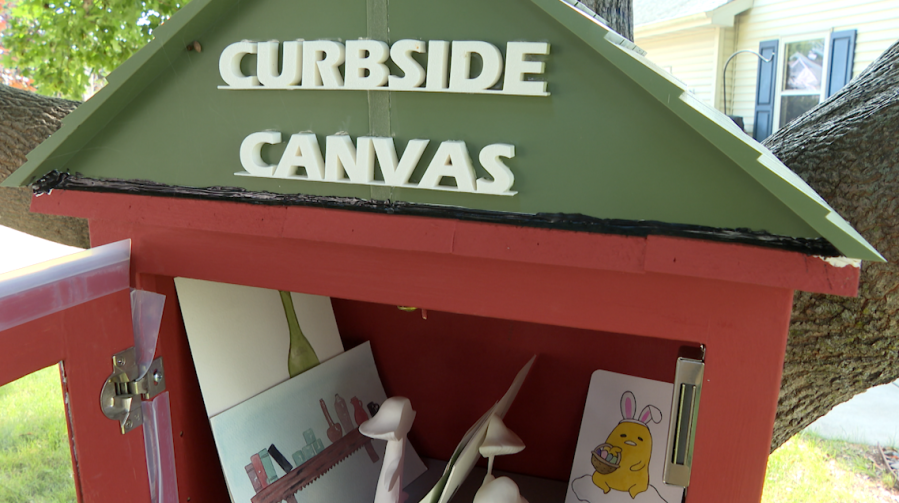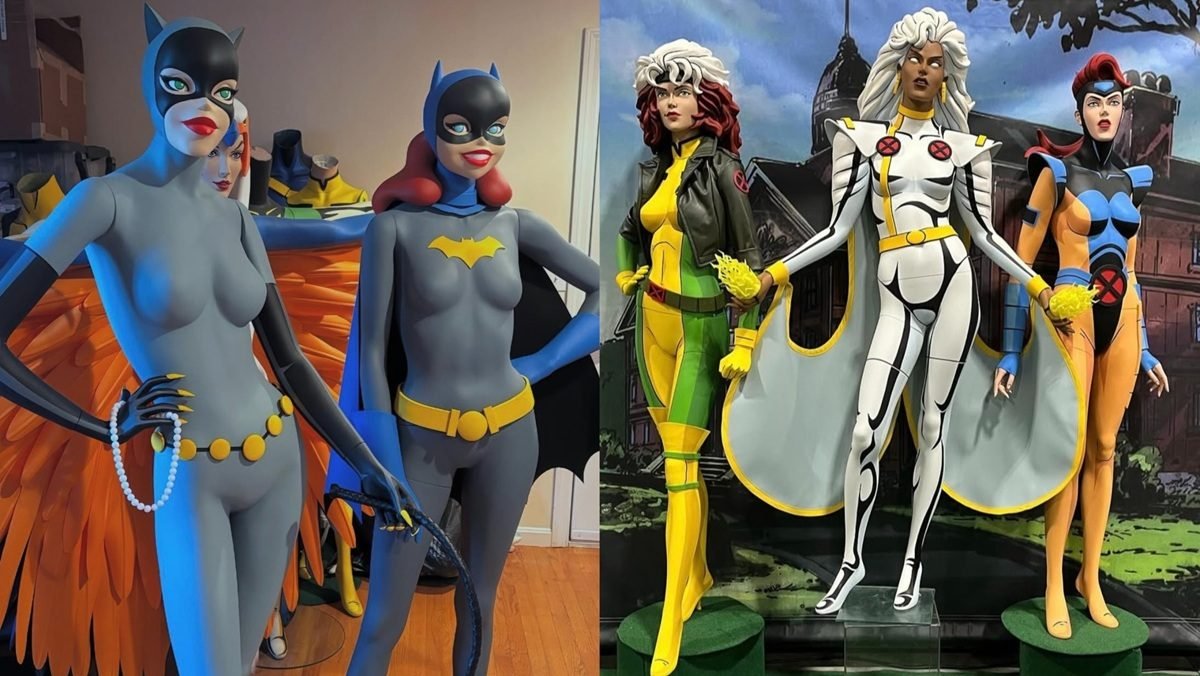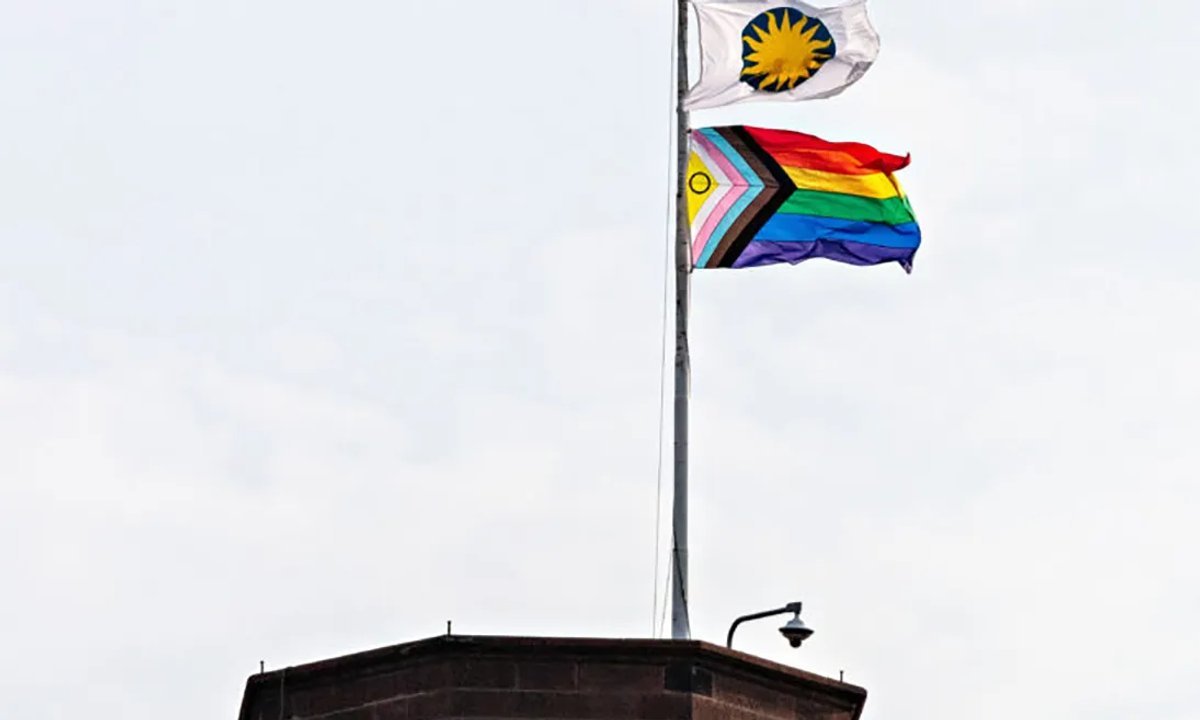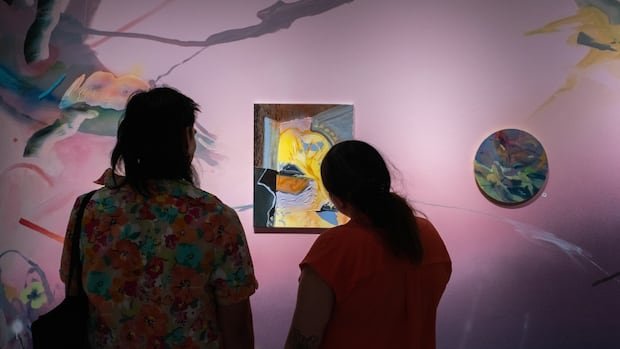Cornelius Tulloch opened his eyes around 6 a.m. as the sun rose gently, reflecting soft colors onto the river. Exotic birds flew over head. Locals drifted by on wooden rafts. Thick tree trunks and low-hanging leaves framed the scene beautifully.
Tulloch, admittedly, is not a morning person, but it was easy to be one as he stayed in a cabin in Pikin Slee, a remote Surinamese village, during an artist residency program last year. The easy-going village of about 3,000 people was a far cry from Tulloch’s usual fast-paced life in Miami, but it still felt like home.
He remembered all of this — the river, the rafts, the foliage, the tranquility — months later when he painted his morning view for a solo exhibition inspired by his time in Suriname.
“Being in Suriname was the first time I’ve ever really slowed down in my life,” he said.
That isn’t an exaggeration. Those who frequent Miami art events have likely run into Tulloch. His outfits are stylish, his smile is bright and his reputation as a talented multidisciplinary artist precedes him.
Born and raised in Miami to a Jamaican father and African-American mother, Tulloch’s art focuses on the beauty and nuances of the Caribbean and African diaspora from a distinctly South Floridian point of view. Since graduating from Cornell University with an architecture degree in 2021, the 26 year old has taken few breaks from creating, exhibiting, networking and traveling.
READ MORE: How a pro-Palestinian artwork placed in a Jewish enclave shook up this Miami arts nonprofit
“I’ve seen him getting his exposure and building up his name and recognition elsewhere, which is so important,” Miami gallerist Andrew Reed said. “It’s a Miami artist who is very clearly breaking out of Miami and establishing himself on a more global stage, which is not easy to do.”
As Miami rises as an international arts hub, Tulloch is one of several local artists whose star is rising, too. He completed a prestigious two-month Bakehouse x Cité internationale des arts residency in Paris, collaborated with Soho House and Porsche, presented a solo show in New York City and debuted work at this year’s Venice Biennale.
And just as he touched down in Miami from Paris, Tulloch was back in the studio preparing for his solo show at Andrew Reed Gallery in Allapattah that opened just a week later on July 11. That same week, he finished painting one of his favorite pieces in the show, the scene he woke up to in Pikin Slee.
IN THE STUDIO
Tulloch’s artistic talent was clear early on.
One day in kindergarten, he remembered, the teacher held a contest: whoever drew the best fire truck would win a trip to the fire station. The teacher asked him to help a classmate who wasn’t very good at drawing. He did help, but a little too well. By the time he finished the student’s drawing, Tulloch barely had time to do his own.
“The kid gets first place, I get nothing. That was my villain origin story,” he said, jokingly. “But that’s when I was like, wow, my drawing won. From there, I just continued sketching.”
He attended Design and Architecture Senior High in Miami, won the 2016 YoungArts award for design and visual arts and was named U.S. Presidential Scholar in the Arts. Though he studied architecture at Cornell, he didn’t see architecture and visual art as separate fields. One of the hallmarks of his work is how he combines the two, like at his immersive 2022 show in Faena or during last year’s Miami Art Week when he installed a whimsical Southern-style porch at Locust Projects.
Artist Cornelius Tulloch inside his studio at the Bakehouse Art Complex. His work is inspired by Miami and the Caribbean diaspora.
Amanda Williams, a renowned visual artist considered to be a leading voice on art and design in the public realm, met Tulloch while he was still a student. Williams, a Cornell architecture school alumna, sat on his final thesis review and has followed his work ever since.
“While I’m not surprised, I am overjoyed at seeing not only the breadth of the work and the caliber of the work and the rigor, but also the advanced evolution,” Williams said. “I’ve been a full time artist for 20 years, and it took a lot of soul searching to get to the point to have the courage to just jump out there. I was actively encouraging him to not spend time doing that and to just jump in.”
While many young artists tend to stick to one particular idea or medium, “he’s not that person,” Williams said.
“He’s going to push each idea to make it better,” she said. “It’s just been breathtaking to watch the range of things, from film, photography, painting, installations. He’s done all of those at a really high level already, and he’s three years into this.”

Carl Juste
/
Miami Herald
The wall in Cornelius Tulloch’s studio at the Bakehouse Art Complex is full of photographs and other images he uses for inspiration.
Tulloch’s studio at Bakehouse Art Complex in Wynwood is home to the vestiges of past and future projects.
Deep blue wooden pieces from the Locust Projects installation leaned next to architecture books and canvases of illuminated tropical fruits. Brightly colored — almost neon — photos of sunsets in the Everglades and hands holding mangoes decorated the walls. Black and white historical photos of a woman in Martinique balancing a bundle of bananas on her head were tacked nearby modern photos of the Caribbean sea and wooden homes painted blue. A bright pink sticky note read: “CREOLE.”
“A lot of my work has been trying to discern visual aesthetics for what my identity is with this Caribbean-American aesthetic,” Tulloch said. “I’m really focused on how does the Caribbean diaspora not only draw from the past, but move forward. How does it continue to grow and adapt?”

Carl Juste
/
Miami Herald
ART OF RELAXATION
Before Tulloch set off to Suriname, a wise woman gave him some advice.
The residency program was organized by Miami arts nonprofit Diaspora Vibe Cultural Arts Incubator. Rosie Gordon Wallace, the nonprofit’s founder and curator, told Tulloch to resist his scholarly urges for once. “You’ll want to do all this research and reading,” she told him. “No, don’t do any of that. Just go and allow yourself to be immersed in the culture.”
“I listened, and I’m so glad I did,” he said.
The artwork in Tulloch’s show, titled “Angisa: a language of living,” was the result of Tulloch’s full immersion into the culture, landscape and people of Suriname. While walking through the gallery, he stopped at a wall-sized tapestry printed with a photo he took as he journeyed through the small South American country. “Suriname is a very trusting place. They told me to trust, so I listened,” he said.
Tulloch quickly learned how relaxed Suriname is compared to the United States, and he was forced to relinquish his tendency to control how he spends his time. In Suriname, he stayed with an artist named Kurt Nahar, who took him on tours and introduced him to folks in the community.
He recalled the trip he took from Paramaribo, the Surinamese capital, to Pikin Slee. He took a taxi to a bus. The bus took him to a dock, where he was told to wait for an hour for a boat. Sure enough, a boat appeared, and he rode for two hours into the Amazon “not knowing what was next.” Despite the mild confusion, Tulloch said, the community embraced him with open arms.
“The people there were like, ‘You look like us. You sure you’re not from around here?’” he said.
The residency in Suriname wasn’t really about creating work, it was about something much deeper. Tulloch ate at a family feast after a funeral, he watched as kids played in the river, he spoke to artists about their wood carving traditions, he hitched rides through the countryside with strangers who quickly became friends. Above all, he said, he learned the art of relaxation.
“Time sitting around isn’t necessarily wasted,” he said. “I really pushed myself to embrace that and move at a slower pace, not worry about every little thing. And honestly, it was life changing.”
The gallery exhibition reflects how connected different cultures actually are, Reed said.
“It’s almost a diary of his time in Suriname, which is a place so unfamiliar to so many people,” Reed said. “But what Cornelius is looking at is how to bring this unfamiliarity and talk about these cultural cross currents.”
Tulloch was given free reign to transform the space, Reed said. The warm, jewel-toned paintings and images pop against mustard-colored walls embellished with large wood carvings.
In several works, Tulloch experimented with texture by adding cold wax to wood to highlight the natural grain.
In one work, decorative wooden hair picks peak through someone’s hair. Another closes in on a hand playing mancala, a game Tulloch used to play as a child. Overhead, the show’s namesake hangs from strings. Angisas, or headkerchiefs afro-Surinamese women wear, are designed with images of braided hair and village neighborhoods.
The most striking works in the show are the portraits, which all feature people Tulloch knows from Miami or Suriname. During the opening night party, crowds of people gathered around a lush portrait Tulloch painted of his friend and fellow artist Rose posing with a bird of paradise flower. On another wall is a portrait of Nahar with his back facing the viewer, showing off a yellow and green jacket that reads “JAMAICA.” In place of his head is a bouquet of yellow and purple flowers.
Cornelius Tulloch’s “Angisa: a language of living,” a solo exhibition at Andrew Reed Gallery in Allapattah. Zachary Balber Courtesy of the artist and Andrew Reed Gallery In another painting, a man sits with his arms crossed in front of him, his face peeks through green leaves and red tropical flowers. It’s a portrait of Miguel, a curator Tulloch met in Suriname. Within the first 10 minutes of meeting, Tulloch said, “he was able to describe my work with words that I didn’t have for my own work.” Tulloch called him a fortune teller.
“[He said] it’s really through the light and color that you’re able to bring people into an experience of your work, into the experience of a moment,” Tulloch said. “And I think that’s when I realized that this is where the power within my work lies.”
NO PLACE LIKE HOME
When asked about the trajectory of Tulloch’s career, his friends and colleagues always make the same point. His work doesn’t just represent Miami, it is Miami.
Laura Novoa, a curator and Bakehouse assistant director of programs and community engagement, said Tulloch and his contemporaries prove that Miami is a relevant cultural hub year round, not just during Art Basel Miami Beach. By now, she said, Tulloch “isn’t even an emerging artist anymore, but just a fixture in the Miami art scene.”
“Choosing to showcase and speak to the Miami community and Caribbean culture shows that he’s doing honest work,” Novoa said. “He’s doing it in a way where it doesn’t matter if it’s in Miami or New York or Chicago or Paris. Clearly, there’s a humanity in his work that resonates with people even when they’re not from Miami.”
And his peers take note of his work ethic. Morel Doucet, a friend and fellow Miami artist, said Tulloch’s success is a testament not just to his talent but also his willingness to collaborate with others and embrace opportunities.
“With Cornelius, it’s his personality, his work,” Doucet said. “He moves with a level of grace and conviction. It’s authentic to his experience. That’s what gets him through the door.”
Since returning from Paris, Tulloch has no plans to slow down. In fact, he’s in the midst of working on a public art project as a way to give back to local communities, he said. During studio visits and interviews earlier this year, Tulloch spoke at length about the importance of archiving Miami’s Black and Caribbean communities, architecture and stories in the face of gentrification. These days, Tulloch doesn’t just feel inspired, he feels reinvigorated.
“This work feels like what I’ve wanted it to feel like for ages,” he said. “It doesn’t feel like an assignment or a job. It feels like I’m exploring and being as creative as I can be.”

Carl Juste
/
Miami Herald
Later this year, he’s working on installing a large scale sculpture at the African Heritage Cultural Arts Center inspired by Southern and Caribbean porches, like the one at his grandfather’s home. Plans are in the works for Tulloch to teach a workshop at Fab Lab Miami, an after school program for students in Liberty City, and collaborate with the students on an art exhibition at the African Heritage Cultural Arts Center. Tulloch’s love for the city of Miami is palpable, and the feeling is mutual. A steady stream of art lovers, curators, artists, collectors, friends and family filled the gallery during the “Angisa” opening night party. The space was buzzing (literally) as people walked from piece to piece, taking in each detail and wondering when he had the time to do this. Guests weren’t just chit chatting, they were celebrating the work.
Artists like Tulloch often feel pulled in many directions. For decades, Miami’s artists were told to leave their hometown to find success in Los Angeles, New York City, Chicago or Paris. But Tulloch’s artistry suggests the opposite. Maybe you don’t have to leave Miami entirely behind. ‘
“It makes me feel like all the energy and effort I put in is worth it,” he said when asked about the reception of his show. “People are really rooting for me and showing up. That’s all you could ask for as an artist, for people to show up,” he said. “I don’t take it for granted. This really is home.”






